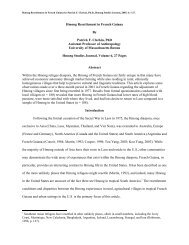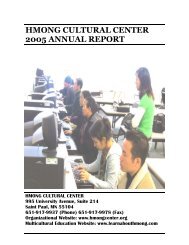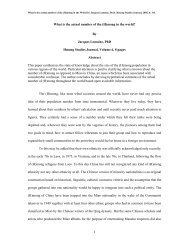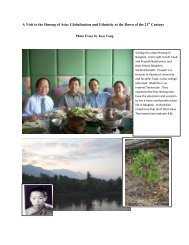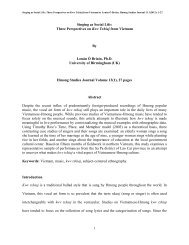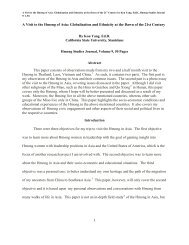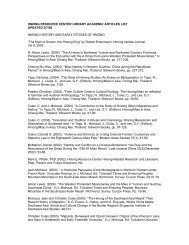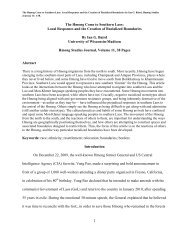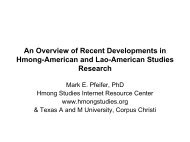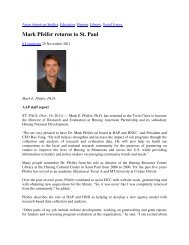Hmong and Lao Refugee Women - Hmong Studies Internet ...
Hmong and Lao Refugee Women - Hmong Studies Internet ...
Hmong and Lao Refugee Women - Hmong Studies Internet ...
You also want an ePaper? Increase the reach of your titles
YUMPU automatically turns print PDFs into web optimized ePapers that Google loves.
<strong>Hmong</strong> <strong>and</strong> <strong>Lao</strong> <strong>Refugee</strong> <strong>Women</strong>: Reflections of a <strong>Hmong</strong>-American Woman Anthropologist by Dia Cha, Ph.D. <strong>Hmong</strong> <strong>Studies</strong> Journal,<br />
2005, 6: 1-35.<br />
since resettled in Western countries such as the United States, Canada, <strong>and</strong> France. 3 As of 1992,<br />
however, about 50,000 such refugees – <strong>Hmong</strong> <strong>and</strong> <strong>Lao</strong> – remained in designated camps in the Thai<br />
hinterl<strong>and</strong>s. Some of these people refused to resettle in Western countries, while others were not eligible<br />
for Western resettlement <strong>and</strong> were due to return to <strong>Lao</strong>s, despite an expressed reluctance so to repatriate.<br />
Indeed, many in the refugee communities of America <strong>and</strong> abroad harbored grave concerns about the<br />
safety of such repatriation.<br />
At all events, no one had voiced any concern specifically with respect to the safety <strong>and</strong> the<br />
welfare of refugee women, despite the fact that, in many ways, they constituted the most vulnerable<br />
component of the refugee population. Some of these women were widows, some were divorcees, <strong>and</strong><br />
some were simply alone after suffering separation from older offspring <strong>and</strong> other close family members.<br />
Many were old <strong>and</strong> weak, or even h<strong>and</strong>icapped; some had no relatives remaining in <strong>Lao</strong>s. In a region,<br />
<strong>and</strong> as members of a society, that is largely male dominated, all women without male assistance <strong>and</strong><br />
support are at risk to some degree. It is in this context that the project detailed herein was undertaken.<br />
The purposes of this project were to assess the needs <strong>and</strong> concerns of refugee women; to address<br />
possibilities for their protection as they planned to repatriate to <strong>Lao</strong>s; <strong>and</strong>, finally, to make<br />
recommendations to the United Nations High Commissioner for <strong>Refugee</strong>s (UNHCR), as well as the<br />
various concerned Non-Governmental Organizations (NGOs), for a course of action which might be<br />
expected to alleviate the uncertainties of repatriation.<br />
Throughout the duration of the project, the author was able to maintain both an insider's <strong>and</strong> an<br />
outsider's perspective. On the one h<strong>and</strong>, the author's own childhood experience as a camp resident<br />
yielded much insight into the character of refugee life, especially the life of refugee women <strong>and</strong> girls. On<br />
the other h<strong>and</strong>, professional training as an anthropologist – training which is geared to the cultivation of<br />
sensitivity, open-mindedness, empathy, <strong>and</strong> a nature which declines to enter into judgment – coupled with<br />
3 In this paper, the terms "resettle" <strong>and</strong> "resettlement" refer to the process whereby refugees move out of refugee<br />
camps to resettle in third nations. The terms "repatriate" <strong>and</strong> "repatriation" may be construed to refer to a process<br />
whereby refugees move out of camps to return to <strong>Lao</strong>s.<br />
2




